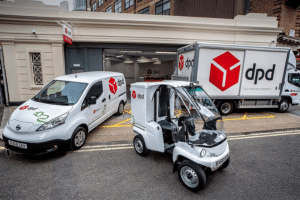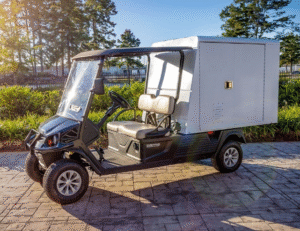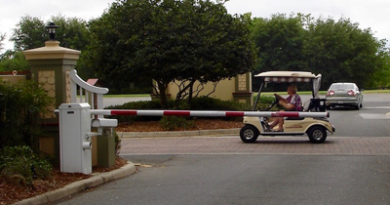Urban Microhubs: An Opportunity for GCT Utility Vehicles
Densely populated urban centers are not usually thought of as a market environment conducive to the use of golf car type (GCT) vehicles. The institution of “micro hubs” in certain major U.S. cities, however, may open a way to market expansion for GCT utility vehicles.
What is a microhub?
A microhub is a device for temporary storage of various articles, which will be delivered to recipients within a limited geographic area. A microhub can also be thought of as the go-between between first-mile and last-mile delivery systems. One such microhub is pictured b to the left in New York City, which is one of three locations on the upper west side of Manhattan
Partnering in the New York pilot project are carriers Amazon, Net Zero Deliveries, and UPS, all of which compete in the fast delivery service business.
On going trials in various cities
Other cities beside New York are participating in filed testing the microhub concept. According to Smart Cities Dive, an online newsletter, cities participating in the initiative are Los Angeles; Pittsburgh; New York City; Washington, D.C.; Santa Monica, California; Oakland, California; Portland, Oregon; and Louisville, Kentucky. Miami-Dade County, Florida, will also participate in the program.
Impetus for these last mile delivery innovations is the significant increase in e-commerce transactions and overnight or one-day deliveries. This, in turn, has led to significant increases in truck traffic in inner cities, with attendant growing congestion and increased pollution.
European expansion of microhub systems

Countries in the European Union are well on the way to embracing the microhub concept. In the U.K. delivery service specialist, DPD , is, as of mid-2022, running all-electric vehicle fleets in 10 UK towns and cities, with the aim of putting their service into 30 municipal areas.
The company looks to expand its all-electric delivery locations into Bristol, Bradford, Hull, Oxford, Southampton and Stoke, and it is on the way to completing the task in 15 more areas, including London, Manchester, Liverpool and Leeds.
It is safe to say that e-commerce and fast delivery are a global phenomenon with substantial expansion ahead in urban centers. And the expansion will not be confined to developed economies, such as the United States and the European Union. One of the key markers of economic development is the movement of populations from the countryside to urban centers. Because of its cost effectiveness as a distribution system, it will move quickly into these developing areas.
The conclusion is that e-commerce, overnight/one day delivery times have become, or are emerging ss, a fundamental lifestyle on a global basis.
Great market opportunity for GCT vehicle manufacturers in the commercial channel.
Right now the main last mile delivery vehicle from the microhub is the e-cargo bike. This makes sense because these vehicles have several desirable features in the microhub delivery system. First, they are non-polluting. Secondly, they do not take up much space on sidewalks or in loading zones adjacent to the microhub.
Cargobikes have some drawbacks, however. They are limited in load capacity. Mose of the models being “peddle-assist” have a limited effective range of operation. Compare this to a GCT utility vehicle. GCT utility vehicles have:
• Load capacities up to 1,000 libs.;
• Distance (operating capability) of up to 35-40 miles;
• Interconnected fleet capability to coordinate routes and charging times.
These advantages would, of course, impact the whole microhub system. Some of the implications are outlined here.
GCT utility vehicle impact on the microhub system
The greater capabilities of a GCT utility vehicle, as compared to a cargobike, would likely influence the design of microhub system for a given location:
• Reduce the number of microhubs for a given location and make the individual microhubs incrementally larger;
• Simultaneously expand the area served by each microhub;
• Potentially reduce inflow, i.e., trips, to the microhub from outside the system.
One challenge that may have to be addressed is the additional burden on the existing electrical grid system. This suggests a conjoint system of microhub and microgrid.
Do manufacturers have the product and the marketing expertise?

The quick answer to the first part of this question is, yes. The Cushman XL LSV is ready for work in a microhub system. The Club Car Current is a similar type of vehicle and also fit for use in a microhub system.
In addition to the fact these models are non-polluting electric powered and have the advantages cited above, both companies have fleet management platforms assuring interconnectedness and fleet usage optimization. Further, these companies (as well as Yamaha) have a well developed network of dealers that can provide servings and parts, as needed. This latter attribute would be a key advantage for GCTs, as opposed to cargo bikes
The answer to the second part of the question is a bit more cloudy. As noted below in SVR’s tentative forecast.
Elements of a forecast of the potential market size and growth
Note the adjective “potential”. The forecast depends on the sales and marketing effort companies like Cushman and Club Car are willing to invest in exploiting the last mile delivery market. This is not a traditional market for companies in the GCT vehicle industry.
Developing this market would mean reaching out to three components of ecommerce/last mile delivery market; namely: 1. Carriers such as Amazon, UPS, and FedEx; 2. Microhub system developers; and 3. Public transportation officials in targeted cities. The interface between public officials and specialized private interests assures that sales and marketing is a collaborative effort across different industries and public and price sectors.
Calculating the fleet size for a hypothetical market area within city
The SVR team developed a model for fleet size in an urban area, using U.S. Census Bureau data for population and geographic area. In this case the team used this data for the city of Los Angeles. According to the Census Bureau, Los Angeles has a household population, as of 2024, of 1.419 million, covering 502.7 square miles. The household density is, therefore, 2,797.9 households per square mile. (The average household size, incidentally, is 2.7 members, indicating a majority of households have children, which would add to the diversity of product needs.)
We make the following assumption for vehicle coverage, variables which can be changed to derive different results of fleet size:
• The individual microhub area or location to be serviced with last mile delivery has a radius of 2.5 miles, with the storage facility at the center;
• The microhub therefore services an area of 6.25 square miles;
• Each GCT delivery vehicle makes 50 deliveries per day; and
• 10% of households within a microhub location require a last mile delivery
Based on the average household density figure for Los Angeles, each microhub would service approximately 54,740 households. Therefore, we can conclude the following, based on the data and the assumed parameters:
• With 10% of household requiring a delivery each day, the number of deliveries would be 5,470;
• Thus, with each vehicle capable of making 50 deliveries per day, you would need about 110 GCT utility vehicles to service a microhub location in Los Angeles.
Changing the variables: Linear vs. Quadratic
It should be noted that the outcome for fleet size can vary dramatically as you change the variable. Fleet size varies proportionally, or linearly, with the percentage of households requiring daily deliveries. Also, the change is linear with respect to household density.
The changes are far more dramatic if you change the area covered by a microhub and its fleet of delivery vehicles. Suppose you double the radius of the covered area, say from two miles to four miles. Market and fleet size are not doubled, but rather, quadruped. This, because the radius is squared in the area formula. (Hello, high school geometry class.)
Bottom line: this is a huge opportunity
Given the variety of neighborhood types and situations, simple formulas cannot be universally applied. The simple formula put together here, however, and that for only one microhub location in Los Angeles points to potentially huge national market. Anyone listening?
________
Contact the Author: Steve Metzger at smetzger@smallvehicleresource.com. Or check out our website at www.smallvehicleresource.com, where you will find an extensive database of vehicle models and can make side-by-side comparisons of vehicles based on a full set of specifications.



